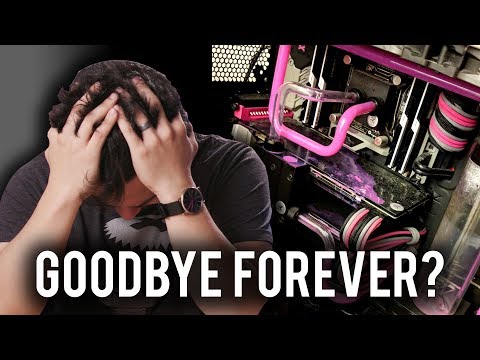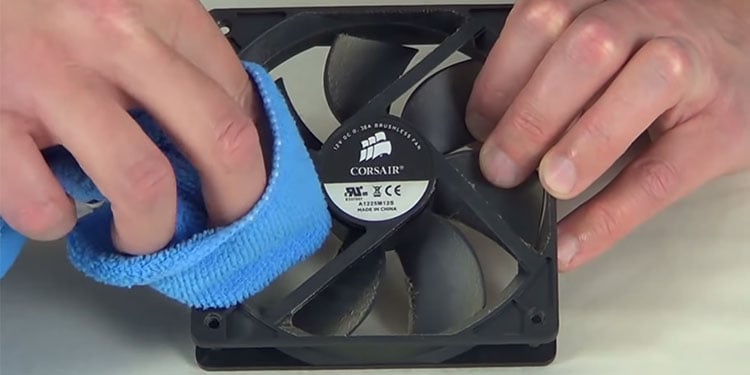Although water cooling a GPU isn’t as common as water cooling a CPU, it’s still very possible – both with kits and by making your own custom loop.
How Does Water Cooling Work?
Most PCs come with air cooling provided by fans, and that’s more than enough to keep the computer cool. However, that isn’t the only cooling option, and it isn’t even the best one for high-end PCs with lots of heat-generating components. It’s very common to see computer enthusiasts add a water cooler to their CPUs. Many also use water cooling to reduce the temperature of a GPU.The liquid moves through the tubes in a water cooling system and draws heat away from system components. A fan and a heatsink also help move the warmth away from the hottest parts. This cools them down and allows your computer to perform better than it might otherwise.
What is an All-in-one System Versus a Custom Loop?
When people talk about an AIO system, they’re referring to buying a kit and installing it. This is a quick process that doesn’t require you to make any decisions about the system because everything comes in a box. Generally, you attach it to specific points on your components and then power it.AIO coolers are more widely available for CPUs than GPUs. However, you can find kits for GPUs on the market. When choosing one, make sure it’s compatible with the exact model of your GPU. A 1080 TI from EVGA can have a different form than one from MSI. You should be able to find a decent AIO kit for any modern GPU, and it likely won’t be too expensive. A custom loop is a water cooling setup that takes a lot more work because you purchase the tubes and other components, fill the lines with liquid, cap them, and put the system together. Custom loops can be much more extensive than AIO solutions. Many people use them to have an even more effective water cooler.
Should I Water Cool My GPU or CPU?
You do not need to water cool your GPU unless you want to. Most of them can keep themselves cool with proper thermal management and enough fans. However, if your GPU is regularly hitting high temperatures, amping up your cooling system with a water cooler might make a significant difference.A CPU cooler is probably a little more necessary than a GPU cooler when it comes down to it. But keeping temperatures low is extremely important, and if you’re willing to spend the time and money installing a GPU cooler, you’ll see lower temperatures.
Are There Any Dangers Associated With Water Cooling?
Although it’s rare, sometimes water coolers will fail, and the liquid will burst out of the tubes. This can damage your components and ruin your computer. Usually, manufacturer warranties are voided if damage results from contact with liquid.
How to Water Cool Your GPU & CPU
There are a few steps involved in water cooling. Each one of them requires careful consideration and a bit of technical knowledge.
Decide What Kind of System You Want to Install
The first thing you have to decide is whether you’re choosing an AIO system or a custom loop. Consider the pros and cons to decide which is right for you.Of course, you can always get a professional to help you install either one of these options, too. It will just be more expensive. If you aren’t interested in putting it together yourself, choosing a system is really all you have to do. Choosing an AIO SystemIf you want to go with an all-in-one kit, look for GPU water coolers that are compatible with your card. You also need to consider the size of the fans and the room available in your case.AIO systems with larger fans will be able to move more air and stay cooler than those with larger fans.Choosing Custom LoopsThe beauty of custom loops is that you can create your own system. You can make a loop that works for any GPU on the market and fits your available space. It’s very customizable. There are certain parts your system has to have, though.
Radiators help move heat away from your components. Each piece you’re trying to cool with your system should have its own radiator. For example, you can use a single loop to cool a CPU and GPU, but each would need its own.Water blocks help cool the liquid that moves through the loop. It’s an integral part of the system because it helps cool the liquid, which then removes more heat from the components.The reservoir is an area that holds water waiting to be released into the loop. Sometimes this is combined with other parts.The pump is what forces the liquid through the loop.Fans help dissipate more heat.Fittings and tubes create the loop itself and hold everything together.The liquid in the tubes is what moves the heat away from the components.
Once you’ve selected all your parts, lay them out so you can prepare to build your system.
Put the Pieces Together
Even the AIO system may have a few things to put together. It entirely depends on the parts you choose.With the custom loop, you’ll have a lot more to do. Not only do you have to connect all the pieces in the proper order, but you also need to check the distance between your computer components. You don’t want to cut your tubes too short.In general, you want the entire water cooler put together before installing it on your PC.
Install the System
Now that your cooler is a unit, you can install it on your PC.Always read through the instructions for each connected piece to ensure you’re putting them all on as the manufacturer intended.
Install Your Software
Your fans and pump might come with some software you can use to adjust their speed. This is very useful for several reasons, including power management and how much cooling you need. Another benefit is that you can manage the noise.Contact your manufacturer to ask what software they recommend if no software is included.
Maintenance and Care
Once your water cooling system is in place, there shouldn’t be much maintenance you have to do. Like most computer components, they’re self-sustaining, and you only need to keep them clean and dry.One thing to add to your list of computer management checkups is to look at the loop periodically and make sure it’s working. Check that there are no drips or leakage. Ensure the hoses aren’t kinked and the fans are working correctly.





